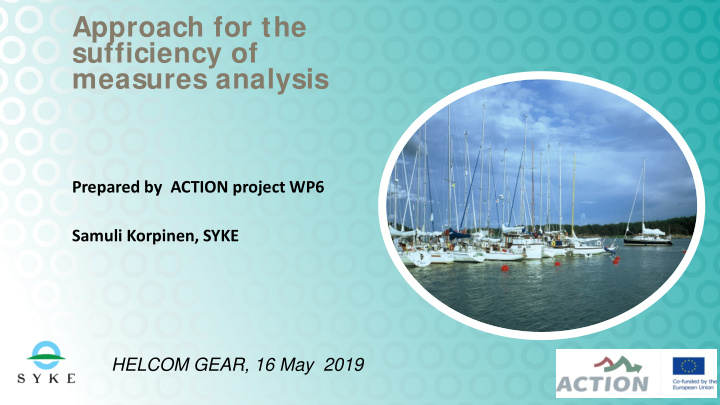



Approach for the sufficiency of measures analysis Prepared by ACTION project WP6 Samuli Korpinen, SYKE HELCOM GEAR, 16 May 2019
GENERAL APPROACH Total reduction of Probability to reach 2 each pressure (%) good state Photo: Jan Ekebom
MEASURES TO BE INCLUDED IN SOM ANALYSES all types, except research, monitoring, coordination, EXISTING MEASURES indicators, targets, information systems/tools etc.) - Type (KTM) measures affecting activities, pressures and state - Link to activity - Implementation time lags: - Time lags - Include measure which still affect the environment - If time lag is beyond BAU period, discuss that separately (!) 3
PRESSURE REDUCTI ON KEY QUESTION: How much a measure will reduce each of the pressures? We need to find out: 1. Each measure’s effect on pressure reduction (per source/activity) 2. Contribution of each source/activity to the pressure 4 Photo: Samuli Korpinen
PRESSURE REDUCTI ON Key Type Measures MSFD Annex (and all the specific III activity and ones listed underneath) pressure lists MEASURE PRESSURE GROUP REDUCTION SURVEY #1 SURVEY #2 CONTRIBUTING TO PRESSURE REDUCTION % Probab A PRESSURE FROM A MEASURE GROUP ility ACTIVITY 1 50 % 0 0.05 ACTIVITY 2 25 % 0-5 0.15 ACTIVITY 3 10 % 5-10 0.7 ACTIVITY 4 10 % 11-15 0.1 ACTIVITY 5 5 % 16-30 0 5 ACTIVITY 6 0 % 31-50 0
PROJECTED DEVELOPMENT OF PRESSURES MEASURE PRESSURE GROUP REDUCTION PRESSURE PROJECTED TOTAL REDUCTION PRESSURE PRESSURE DEVELOPMENT REDUCTION 6 Photo: Jouko Lange
Can we achieve good state? (or our pressure targets) - State targets (e.g. biodiversity) How much pressures have to be decreased to reach GES for different state components? - Pressure targets (e.g. nutrient inputs, marine litter) 7
Can we achieve good status? DEFINE AND PRIORITIZE RELEVANT PRESSURES FOR EACH STATE COMPONENT PROBABILITY FOR GES PRESSURE REDUCTION % Photo: Samuli Korpinen
9 Photo: Heidi Arponen
Recommend
More recommend